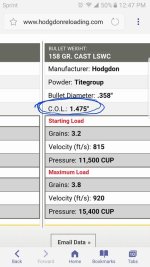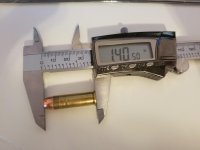Your overall length looks okay. I can just about make out the crimping cannelure. You'll note that the book load is a 158-grain lead semi-wadcutter, and you've got some sort of RNFP, plated I'm guessing.
Take a look at this little lineup of bullet designs:
You'll see that if you loaded them all to the same OAL, then they would have vastly different case volumes. Hence, with revolver cartridges, I generally ignore the printed OAL data and use the crimping groove. The bullet and die makers know what they're doing.
I'd also suggest that your load is probably a little hotter than necessary. You could likely back off a fair bit and get the same or better results. Typically, if I'm looking for a low-recoil target load, I first try the starting load and then adjust up or down from there. If I want something with more heat, I start in the middle of the range and work up.
If nothing else, you'll be saving some wear and tear on your gun.



